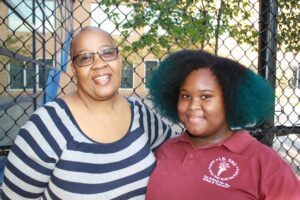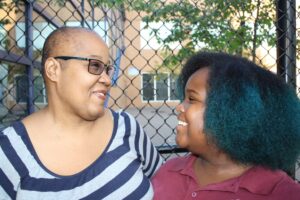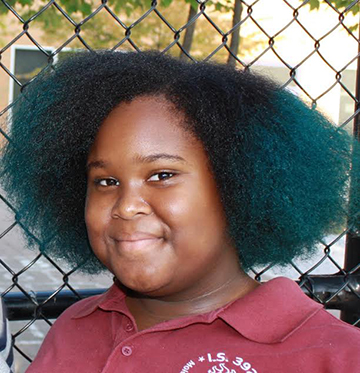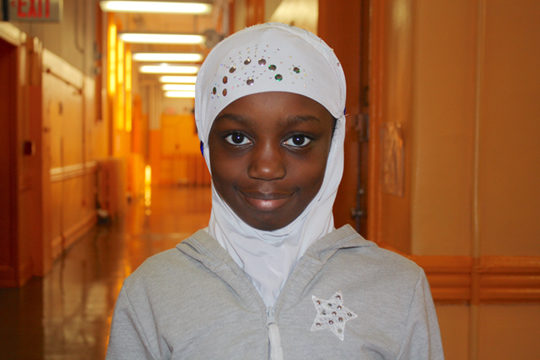Savannah (pictured here with her mother, Pauline) is a student in a Brooklyn, New York public middle school and was in a seventh-grade class taught by writer and T&W teaching artist Liz Arnold in the spring of 2015. She spoke with editor Susan Karwoska in May and—along with her mom—again in September about what the class meant to her as she was going through a particularly difficult time in her life.
*

Teachers & Writers: Was this the first time you’ve written poetry?
Savannah: I’ve written poems before, but I never really got into it as much as I did with this class. Miss Liz made writing poems really interesting and entertaining, so that we wanted to try it.
T&W: What’s the most important thing you got from the class?
Savannah: It helped me to handle bad news. Two months before the class started, I found out that my mom has breast cancer. That got me really upset and I stopped focusing a lot. Then Miss Liz came in and started teaching this class and I thought, “Maybe I’ll take out my feelings in my poems.” The first time I wrote about my mom it was a little scary, because I knew I was going to have to read it to the class and I really didn’t want people to feel sorry for me.
T&W: Were you surprised by what came out in your poem?
Savannah: I was surprised because I didn’t realize I had the talent to write like this.
T&W: What was it like to share your poem with your mom?
Savannah: It wasn’t hard. I kind of knew what her reaction would be, but I was surprised when she actually cried.

Pauline: That morning I went to church, and when I came back home, Savannah gave me the book with a Mother’s Day card, and I said, “What is this?” And she said, “Mommy, just read it.” I said, “No, you read it,” because I was already starting to cry. When she finished I said, “This is beautiful!” I showed it to everybody who came to the house and they’d say, “Man, this is deep!” And it is deep. I didn’t know she was going through all that because I talked to her about what was happening, but deep down she felt that she was going to lose me. I had to reassure her and tell her, “Savannah, I’m doing everything I can to live for you, because there’s a lot of things you haven’t done yet, and I want to do them with you.”
I have to give a shout out to her teachers. They really helped her when she was struggling. And her friends were there for her too. They checked on her every day. The battle is not over yet, but I’m still fighting it, and I want Savannah to stay strong and focus on school.
*
Breast
By SavannahGo inside a breast.
That would be my way.
Let someone else die
or struggle with the disease.
I am upset to be this breast.From the outside, the breast is beautiful, brown skin.
No one knows what’s inside, let’s go.
Inside is a fiery pit.
Even though the disease is curable,
even though it’s saved,
the breast becomes stiff, slowly dies.
To the lump of the breast,
where the disease comes to land
and kill.I have seen and felt lumps
When I examine my breast.
Perhaps I am dying
from top to bottom.
Just enough light to die.
The suspicious figure
in the sky.
*
Lesson Notes
By Liz Arnold
Savannah’s powerful poem was written in response to a lesson about imagery, points of view, and “third eye” perception, modeled on Charles Simic’s poem, “Stone.” (I adapted a great lesson by my T&W colleague, Joanna Fuhrman, and you can read her lesson here.) I started class by passing out “third eye” stickers: eyes I’d drawn on round white circles for students to place on their foreheads. The students were instantly intrigued. I asked questions to gauge their level of knowledge: Who’s heard of the third eye? What is intuition? What can you “see” that isn’t physical? Poets, I explained, can see things in their imaginations, and they express themselves in language.
Next, I passed out copies of “Stone,” and volunteers read it aloud. I started with a few questions: What are some images you like? What does the poet “see”? What are some things outside the stone? What are some things inside the stone? The students noticed that the narrator could see the stone underwater, and imagine what it’s like inside. Then I asked them to brainstorm what other things they could imagine going inside—ideally small things, in which they could imagine larger things, as Simic imagines a moon shining inside the stone. Drawing on their awareness of their third eyes, the students raised their hands (many with closed eyes) and described seeing mature oak tress inside acorns; a father’s hug inside a golden locket; and red velvet shoes dancing inside a blooming rose.
By the time we’d brainstormed objects to write about, Savannah was already writing. When it came time to share, she was one of the first to raise her hand. Her bravery silenced the room, and her reading was the first time many of the students heard about what she and her mother were going through. On a technical note, her poem is impressive in that it mirrors very closely—nearly line by line—the structure and tone of Simic’s. She even begins some lines with the same phrases and conveys emotion in the same places that he does. But what’s more impressive is that in doing so with her own deeply personal material, she made the poem her own. I think we all left that day feeling fortunate to have witnessed the emerging voice of a talented young writer.
Teachers & Writers Magazine is published by Teachers & Writers Collaborative as a resource for teaching the art of writing to people of all ages. The online magazine presents a wide range of ideas and approaches, as well as lively explorations of T&W’s mission to celebrate the imagination and create greater equity in and through the literary arts.



